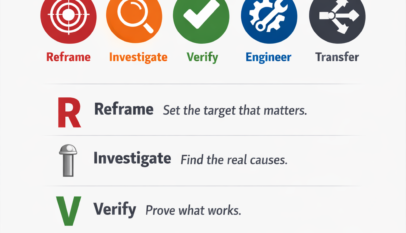Effective plant maintenance management is essential in optimizing productivity, enhancing operational efficiency, and reducing costs in the modern industrial sector. To achieve this, a comprehensive management concept has been developed, which covers eight key areas ranging from manufacturing support activities to maintenance skills training. Each of these areas is accompanied by critical questions that aid in assessing and guiding the implementation and effectiveness of these activities.
The approach expands into three parts of Total Productive Maintenance (TPM) that provide a deeper understanding of maintenance strategies and initiatives. Each part focuses on different aspects and raises essential questions to facilitate the successful implementation and ongoing improvement of plant maintenance. This framework is a valuable guide to ensure that plant maintenance operations align with the best practices, ultimately leading to enhanced equipment uptime, improved product quality, and increased profitability.
| No. | Approach to Plant Maintenance | Questions |
|---|---|---|
| 1 | Manufacturing Support Activities | Is there sufficient commitment to breaking away from breakdown maintenance and setting up a PM system? |
| 2 | Activities to Reduce Failures to Zero | Do operators sufficiently understand the importance of their participation in plant maintenance? |
| 3 | Establishment of a Maintenance Plan Management System | Are efforts made to shift from TBM to CBM from a production maintenance point of view? |
| 4 | Creation of a System for the Management of Maintenance Information | Are both the operating sector and maintenance sector working to build a new approach to maintenance systems? |
| 5 | Spare Parts Management | Are the operating and maintenance sectors working to build a new approach to maintenance systems? |
| 6 | Creation of a Predictive Maintenance System | Is CBM introduced, and is diagnostic technology partially developed in-house? |
| 7 | Lubrication Oil Management | Are lubricating oil and operating oil managed, using an oil stand and the like? |
| 8 | Training in Maintenance Skills | Are almost 100% of maintenance workers machine maintenance technicians? |
At the heart of the relentless pursuit of operational excellence lies Total Productive Maintenance (TPM), a systematic approach to maintaining and improving the integrity of production and quality systems. Through this deep dive, we dissect the nuanced layers of TPM, delving into its foundational principles, practices, and milestones to gauge its effective implementation.
From the bedrock principles of autonomous maintenance, sporadic failure reductions, and maintenance calendaring in TPM Part I, we transition into the advanced realm of integrated information management systems, the shift of maintenance responsibility, and the crucial nexus between equipment and quality in TPM Part II. As we ascend further into TPM Part III, the focus sharpens on the futuristic facets of maintenance—how we select, monitor, train, and integrate for a holistic approach that drives towards zero failures and zero defects.
TPM Part I
- Is autonomous maintenance sufficiently supported?
- Have failure analysis, recovery, and improvement been sufficiently carried out and have significant reductions in sporadic failures been achieved?
- Are maintenance standards prepared, and is PM carried out according to a maintenance calendar?
TPM Part II
- Are maintenance records carefully recorded, and is an information management system in place?
- Has part of the maintenance work shifted from the professional maintenance sector to the operating sector?
- Is the relationship between equipment and quality understood, and is plant maintenance for zero quality defects in place?
- Is maintenance work being reviewed, and is IT adopted to enable economical, planned maintenance?
- Is computer-based information management applied in PM?
- Are corrective maintenance and integration used to reduce the number of spare parts?
- Is the shift from TBM to CBM aggressively pursued?
- Are aggressive measures to reduce the volume of oil used undertaken to conserve resources?
- Does the plant have any experts in equipment diagnosis? Is a system in place for the training of such people?
TPM Part III
- Is the optimum maintenance form always selected, focusing on constant monitoring under CBM?
- Is a comprehensive new maintenance system established?
- Is a support system established in which operators consider themselves part of the plant maintenance effort?
- Is a plant maintenance system for zero failures and zero defects firmly entrenched?
- How much progress has the plant made toward establishing an intranet to integrate production, quality, and equipment information?
- Is plant monitoring pursued from a variety of angles?
- Can plant deterioration be analyzed using lubrication oil analysis?
- Is a training system in place for continuous passing-on of skills and advanced skills training?
Effective plant maintenance management is a multi-faceted process critical to ensuring seamless manufacturing operations. The comprehensive approach outlined in this guide provides a clear pathway toward achieving optimal plant maintenance by focusing on eight crucial areas of activity, coupled with thoughtful inquiries that can drive improvements. Furthermore, the Total Productive Maintenance (TPM) parts are a roadmap to navigate and enhance maintenance strategies.
Implementing this approach requires a holistic understanding and commitment from a manufacturing plant’s operating and maintenance sectors. It involves the creation and management of maintenance systems and resources. It emphasizes the importance of staff training, an understanding of quality relationships, and the application of information technology in plant maintenance.
Adopting these practices will promote proactive maintenance over reactive maintenance, reduce failures, conserve resources, and enable a shift towards advanced methods such as condition-based maintenance (CBM). Ultimately, this diligent and comprehensive approach to plant maintenance will contribute to improved operational efficiency, equipment longevity, and overall business profitability.


















